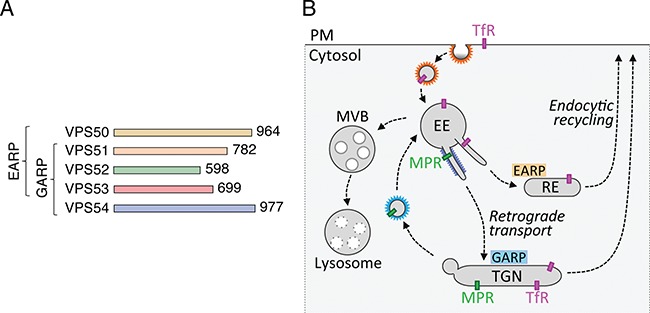Figure 1.

Characteristics of GARP and EARP. (A) The GARP complex is composed of VPS51, VPS52, VPS53 and VPS54 subunits, whereas the EARP complex is composed of VPS50, VPS51, VPS52 and VPS53 subunits (1,2). GARP and EARP were also previously referred to as VFT (VPS fifty three) (3) and GARPII (7), respectively. VPS51 is also known as Ang2 (another new gene 2) (6,38), and VPS50 as syndetin (8) or VPS54L (7). The number of amino acids in each protein is indicated (according to UniProt, http://www.uniprot.org/). The subunits of GARP and EARP are elongated proteins belonging to the family of `complexes associated with tethering containing helical rods' (39). The four subunits of the mammalian complexes are thought to assemble via their N-terminal regions into an X-shaped structure (40). (B) Schematic representation of the localization and function of GARP and EARP (adapted from ref. 8). GARP mediates tethering and fusion of endosome-derived carriers to the TGN, while EARP functions in tethering and fusion of endosome-derived carriers with recycling endosomes. GARP also plays a minor role in this latter pathway. EE, early endosome; MVB, multivesicular body; PM, plasma membrane; RE, recycling endosome; MPR, mannose 6-phosphate receptor; TfR, transferrin receptor.
